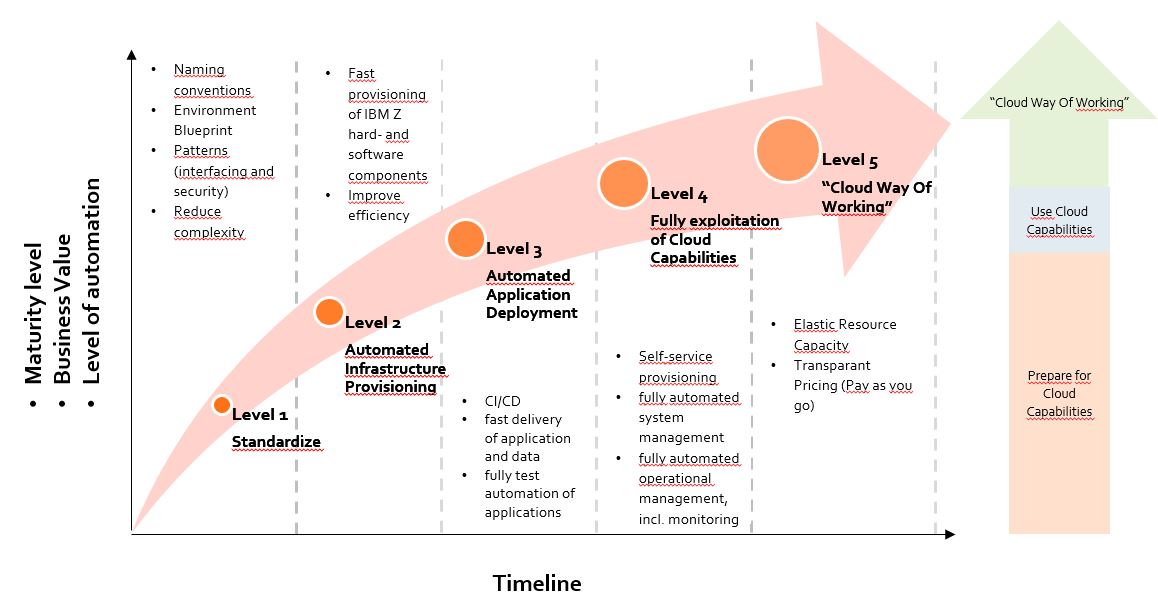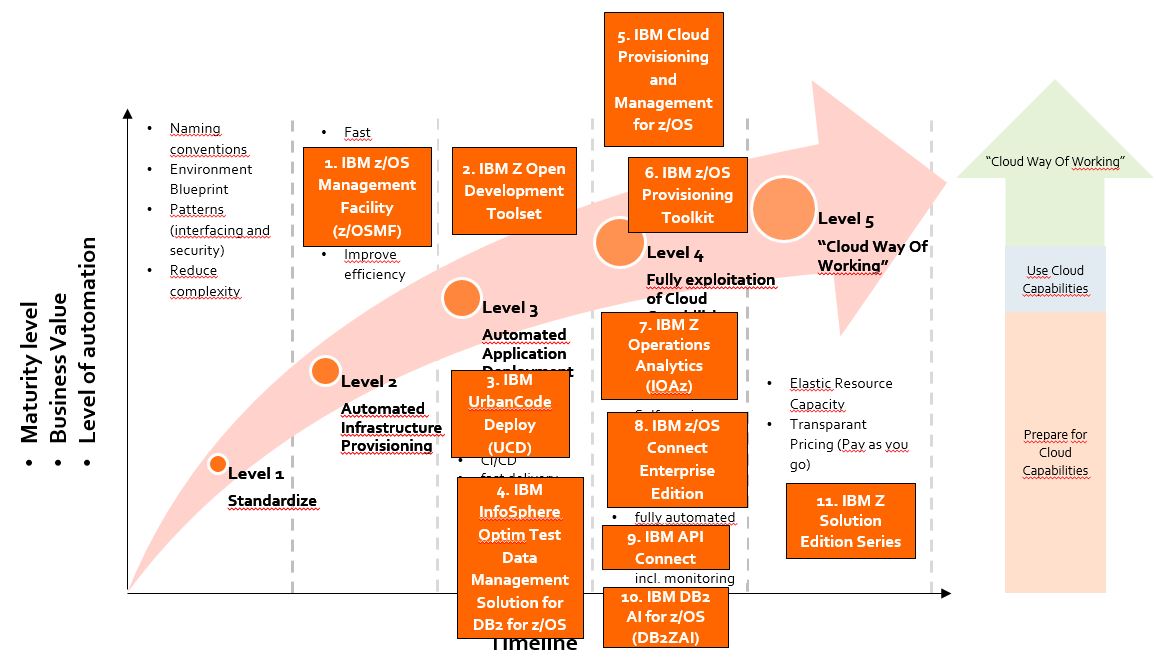From Legacy to a Cloud Way of Working
In my last blog I looked back to the past in a slightly satirical way, but now it’s time to start doing some serious business.
Organizations wants to lower costs and shorten their time to market. To achieve this some organizations establish a “Public Cloud First” Strategy and are accelerating the migration of their applications to a Public Cloud.
On a short term most of these organizations will not migrate their IBM Z environment to a Public Cloud, but unlocking IBM Z to cloud parties does require short term attention.
Besides that, cost reduction and shorter time to market also applies to IBM Z.
This article describes a possible approach to evolve a legacy IBM Z environment to an environment that fully adopts a Cloud Way of Working.
Organizations needs their mainframe to act as a World Class Cloud
Unlocking IBM Z to cloud parties means that IBM Z itself must behave more and more as a Cloud, or in other words IBM Z has to adopt the Cloud concepts and capabilities. This means that you must have the following ambition for your IBM Z environment:
- Standardize everything
- Automate everything, meaning that:
- Teams working on the IBM Z platform are fully “self-servicing”, which means the teams are able to automatically manage their own environments, applications and data without having deep knowledge of the IBM Z environment and components. To achieve this the teams use on demand services, that are always on, anywhere, anytime any place and accessible from anywhere by very simple standard interfaces or APIs
- The IBM Z platform is fully self-tuning/self-managing including Monitoring, Incident and Operations Management Integration and Elastic scaling up and down in capacity and functionality as needed
- Make it competitive in terms of costs and short time to market. A flexible, transparent pricing (real Pay-as-you-Go) is a must
- Open up the IBM Z platform to the outside world and make it easy accessible through APIs
Now, let’s talk about a possible approach to reach that ambition. For the sake of the length of this blog I will stick to mentioning only the highlights that I believe are most important. If you want me to drill down a little deeper please let me know and I will be happy to spend a few more words on this topic.
No Standardization = No Cloud Way of Working
If you want to move to the Cloud you must follow the standards that the Cloud provider requires. Every deviation from these standards comes with higher costs and a higher risk on a Cloud provider lock in. This is true for every on-site workload that you want to move to a Public Cloud and is independent of the platform that the workload is running on.
So I believe that moving existing on-site workload to a Public Cloud should always start with standardizing your own environments. Doing that enables you to move to a Public Cloud in a smooth, cost-effective way.
Without standardization you can forget about moving to a Cloud Way of Working because you will run into huge system management problems.
Standardization for me is the most important part of achieving our ambition. It’s the foundation that has to be solid as a rock. If I had to invest my money I would invest it into standardization. From an IBM Z perspective, standardization will not be easy.
IBM Z is a platform that is shared by multiple people working for multiple parts in the organization. Typically they all use their own divers standards for a long time already and are very familiar with these.
Coming up with a standard that is accepted by people that are used to their own standards for 10, 20 years or more is a challenge. Let’s try to give a brief summary of what I think are the most important things.
- Without standardization an organization can forget about moving to a Cloud Way of Working because you will run into huge system management problems.
- Standardizing is hard work, but necessary to put down a solid foundation for moving to a Cloud Way of Working. That foundation has to be solid as a rock.
- Keep the standard as simple as possible. That will help us in the ability to move through the next levels a lot faster. Once you start automating, tools are needed. By keeping the standard simple you are able to easily configure the tooling.
- Don’t sit back and assume that vendors are going to solve your challenges with magic tools. They can’t! They can help you but you have to do the hard work yourself.
- Stick to the standards! Don’t allow deviations even if they seem to be not that harmful. Of course there must be room for improvement but implement a heavy governance to guard the standard. Keep in mind that once you have a standard you want to implement that standard with easy configurable tools. As soon as deviations has to be built in for some cases and/or for some people you end up with a lot of custom build complexity in the tools, making these tools not maintainable and not flexible. The risk of not reducing complexity or even increase complexity is very high and ending up with spending a lot of resources for just replacing some old tools by some new ones is a very likely scenario in that case.
Steps towards the vision - From Legacy to "Cloud Way of Working"
Now we have standardized our environment (or at least worked out on paper what our new standards are) we can start working our way through the different steps that we have to take to adopt a Cloud Way of Working. The steps are defined in the next figure.

Steps towards the vision – From Legacy to “Cloud Way of Working”
This figure identifies the main themes that we have to work on. It enables us to define and prioritize requirements that the IBM Z platform has to deliver. In other words, with this as guideline, we are able to make a roadmap that makes it possible to migrate to a Cloud Way of Working in a controlled, manageable way.
As an example you can start by automating the provisioning of a standard infrastructural environment. On top of that you can
then work on automatic deployment of your applications including the providing of (test)data.
Once you are able to set up an environment like this with one push on a button you really are making steps forward. That’s the time you can start thinking about Continuous Testing and Continuous Delivery.
After that you have all the building blocks in place to let the teams move to fully self-servicing teams, meaning they are able to
automatically manage their own environments, applications and data without having deep knowledge of the IBM Z environment and components.
By making the costs transparent you can make visual what the teams really spend. This is the last step to reach your ambition.
One of the biggest advantages of this step-wise approach is that you can improve efficiency right away. You don’t have to wait until you fully adopted a Cloud Way of Working.
IBM Solutions
Without the intention to make an exhaustive list, let’s see if IBM can help us with their solutions by plotting some of these
solutions into the picture. Solutions that can help you to get going.

-
IBM z/OS Management Facility (z/OSMF) allows you to fast provision your IBM Z infrastructure.
Choosing z/OSMF as you standard provisioning tool is a very good point to take off. With z/OSMF you can start provisioning the environments you need in a fully automated, standard way. It enables you to streamline and automate z/OS tasks more and more.
Your z/OSMF artefacts can be exposed through REST APIs which opens up a lot of more opportunities, like integrating z/OS into a self-service provisioning portal. -
IBM Z Open Development Toolset is a starter toolset that allows you to fast deliver and test applications. z/OS development teams can include their z/OS application components with an established, open DevOps toolchain. For example a tool like Git allows z/OS and distributed development teams work together in a shared Software Configuration Management environment. By using IBM Dependency Based Build developers are able to build and
deliver to a common delivery pipeline, such as Jenkins. The toolset comes with Eclipse based editors and includes IBM z/OS Debugger that delivers debug capabilities. For automated unit test capabilities IBM Z Open Unit Test is included. -
IBM UrbanCode Deploy (UCD) is a tool for automating application deployment. With standard plugins for different types of applications (like CICS, DB2 or MQ) you can automatically deploy your z/OS applications without any manual intervention.
-
IBM InfoSphere Optim Test Data Management Solution for DB2 for z/OS can be used for creating test databases that are relational intact (masked) subsets of existing production databases.
-
IBM Cloud Provisioning and Management for z/OS is a z/OSMF plug-in that enables rapid provisioning and de-provisioning of z/OS middleware environments in an automated and self-service manner. It can help us in reaching our ambition that teams working on the IBM Z platform are fully “self-servicing”.
-
IBM z/OS Provisioning Toolkit, is a command line utility for the rapid provisioning and de-provisioning of z/OS development environments without requiring any z/OS specific administration skills. The toolkit uses IBM z/OSMF to define workflows that can provision runtime environments and IBM Cloud Provisioning and Management to manage and control those workflows. The toolkit can help us in reaching our ambition that teams working on the IBM Z platform are fully “self-servicing”.
-
IBM Z Operations Analytics (IOAz) provides actionable insights into the health of your IT operations environment. IOAz uses machine learning to proactively detect emerging issues across services, so you can proactively alert and cognitively adjust to changes. With IBM Common Data Provider as part of IOAz you are also able to collect z/OS data and forward it to other operational analytics platforms, such as Splunk.
The ultimate goal is to have self-tuning systems and IBM is starting to leverage machine learning as a way to evolve to these self-tuning systems. -
IBM z/OS Connect Enterprise Edition allows you to make your IBM Z assets transparently accessible with REST APIs. Also it allows you to access REST APIs in a Cloud environment from IBM Z. This means that IBM Z becomes able to fully participate into a Cloud world.
-
IBM API Connect is an API management solution that addresses all four aspects (create, run, manage and secure) of the API lifecycle.
-
IBM DB2 AI for z/OS (DB2ZAI) is leveraging machine learning technology to find patterns and learn the optimal access
paths for queries entering DB2 for z/OS, unique to your environment. These insights helps the query optimizer to identify the most optimal access paths for SQL statements. The ultimate goal is to have self-managing systems. On a very short term this will not be realized, but it is interesting to see that IBM is starting to leverage machine learning as a way to evolve to these self-managing systems. Therefor DB2ZAI is an interesting example. -
IBM Z Solution Edition Series can help us to reach our ambition around Elastic Resource Capacity and Transparent Pricing. A Solution Edition is a packaged offering that brings together key components of hardware, software and
maintenance, all at a transparent price. No more “price plexing”, but using the capacity of your machine where you need it for. Interesting in the context of this article is the “Solution Edition for Application Development and Test“.
To Cloud or not to Cloud?
Once you adopted and implemented a Cloud Way of Working for your IBM Z environment the last step to take is to decide whether to move the IBM Z environment to a Public Cloud or not.
But that should be a piece of cake by then because you now reached a level of maturity in which everything is fully automated and cost transparent in a way that you can make an objective decision if moving to a Public Cloud still offers additional benefits.
Harry van Irsel has more than 30 years of experience in IT, specialized in mainframe innovation, architecting and engineering. He has a strong vision on innovation and is always motivated to find innovative solutions for addressing emerging needs of the organization or enhance existing services.
Propagating vision and belief in the mainframe in a constructive and objective way combined with the passion to combine traditional and modern technologies to produce the “best-of-both-world solution” resulted in winning several Innovation Awards.
Harry is also 2018, 2019, 2020 and 2021 IBM Champion for innovative thought leadership in the technical community.

“Views expressed in this article are my own”.

Harry, very nice blog; I couldn’t agree more that standardization and simplification is needed for the z/OS environment to be part of the hybrid cloud journey.
It is the work of the new system programmer to make that happen by first embracing z/OSMF to transfer the processes they own into simplified workflows.
As off today, I don’t know many customer who started doing that!!